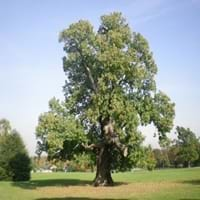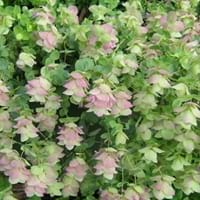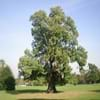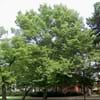Life Span
Perennial
Perennial
Origin
China, Korea
Hybrid origin
Types
Not Available
Kent Beauty
Amethyst Falls
Barbara Tingey
Number of Varieties
Not Available
Habitat
disturbed sites, Forest edges
Grassland, Open scrub, Rocky areas
USDA Hardiness Zone
4-8
5-8
Sunset Zone
2a, 2b, 3a, 3b, 4, 5, 6, 7, 8, 9, 14, 15, 16, 17
Not Available
Habit
Spreading
Clump-Forming
Minimum Height
Not Available
Minimum Width
Not Available
Flower Color
White, Light Yellow, Ivory
Pink
Flower Color Modifier
Bicolor
Bicolor
Fruit Color
Light Green, Chartreuse
Not Available
Leaf Color in Spring
Green, Gray Green
Dark Green
Leaf Color in Summer
Gray Green, Dark Green
Dark Green
Leaf Color in Fall
Yellow, Gold, Tan
Dark Green
Leaf Color in Winter
Not Available
Light Green
Plant Season
Spring, Summer, Fall
Summer, Fall
Sunlight
Full Sun
Full Sun
Type of Soil
Clay, Loam
Loam
The pH of Soil
Acidic, Neutral
Neutral, Alkaline
Soil Drainage
Well drained
Well drained
Bloom Time
Late Spring, Early Summer
Late Summer, Early Fall
Tolerances
Drought
Drought
Where to Plant?
Ground
Container, Ground, Pot
How to Plant?
Seedlings, Stem Planting
Seedlings
Plant Maintenance
Low
Medium
Watering Requirements
Do Not over Water, Medium, Requires watering in the growing season
Allow soil to be completely dry in between waterings, Does not require lot of watering, Water twice a day in the initial period, Water when soil is dry
In Summer
Adequately
Lots of watering
In Spring
Moderate
Moderate
In Winter
Average Water
Average Water
Soil pH
Acidic, Neutral
Neutral, Alkaline
Soil Type
Clay, Loam
Loam
Soil Drainage Capacity
Well drained
Well drained
Sun Exposure
Full Sun
Full Sun
Pruning
Prune in fall, Remove damaged leaves, Remove dead branches, Remove dead leaves
Remove damaged leaves, Remove dead branches, Remove dead leaves
Fertilizers
Nitrogen, Potassium
All-Purpose Liquid Fertilizer
Pests and Diseases
Beetles, Leafhoppers
Red blotch
Plant Tolerance
Drought
Drought
Flower Petal Number
Not Available
Single
Fragrant Leaf
No
Not Available
Foliage Texture
Coarse
Fine
Foliage Sheen
Glossy
Matte
Attracts
Not Available
Butterflies
Allergy
Mild Allergen
Not Available
Aesthetic Uses
Not Used For Aesthetic Purpose
Showy Purposes
Beauty Benefits
Not Available
Not Available
Environmental Uses
Air purification, Food for animals, Food for birds, Food for insects, Nesting sites for birds, Prevent Soil Erosion
Air purification
Medicinal Uses
Low calories, Nutrients
Bloating, Bronchitis, Cough, Cramps, Croup, Gastrointestinal disorders, Headache, Rheumatoid arthritis, Urinary tract problems
Part of Plant Used
Fruits, Seeds, Stem
Leaves
Other Uses
Food for animals, Used as firewood, Used As Food, Used in biomass
Employed in herbal medicine, Used As Food
Used As Indoor Plant
No
Yes
Used As Outdoor Plant
Yes
Yes
Garden Design
Edible, Feature Plant, Shade Trees, Street Trees
Container, Edging, Groundcover, Mixed Border
Botanical Name
CASTANEA mollissima
ORIGANUM 'Rose Dome'
Common Name
Chinese Chestnut
Ornamental Oregano
In Hindi
चीनी अखरोट
सजावटी अजवायन
In German
chinesische Kastanie
Ornamental Oregano
In French
châtaignier chinois
ornement origan
In Spanish
Castaño chino
Ornamentales orégano
In Greek
Κινέζικο κάστανο
καλλωπιστικά Ρίγανη
In Portuguese
castanha chinesa
ornamental Oregano
In Polish
Kasztan chiński
ozdobne Oregano
In Latin
Chinese Chestnut
decentius Oregano
Phylum
Tracheophyta
Not Available
Class
Magnoliopsida
Magnoliopsida
Order
Fagales
Not Available
Family
Fagaceae
Lamiaceae
Clade
Angiosperms, Eudicots, Rosids
Angiosperms, Eudicots
Tribe
Gloxinieae
Mentheae
Subfamily
Cassidinae
Pitcairnioideae
Number of Species
Not Available
Not Available
Difference Between Chinese Chestnut and Ornamental Oregano
If you are confused whether Chinese Chestnut or Ornamental Oregano are same, here are some features about those plants to help you choose better. Many people think that these two plants have the same characteristics, but one can see Chinese Chestnut and Ornamental Oregano Information and learn more about it. Fertilizers required for proper growth of Chinese Chestnut are Nitrogen and Potassium, whereas for Ornamental Oregano fertilizers required are All-Purpose Liquid Fertilizer. Hence, one should know the basic difference between Chinese Chestnut and Ornamental Oregano if you are planning to have them in your garden to enhance its beauty.
<
Flowering PlantsImportance of Chinese Chestnut and Ornamental Oregano
Want to have the most appropriate plant for your garden? You might want to know the importance of Chinese Chestnut and Ornamental Oregano. Basically, these two plants vary in many aspects. Compare Chinese Chestnut and Ornamental Oregano as they differ in many characteristics such as their life, care, benefits, facts, etc. Every gardener must at least have the slightest clue about the plants he wants to plant in his garden. Compare their benefits, which differ in many ways like facts and uses. The medicinal use of Chinese Chestnut is Low calories and Nutrients whereas of Ornamental Oregano is Bloating, Bronchitis, Cough, Cramps, Croup, Gastrointestinal disorders, Headache, Rheumatoid arthritis and Urinary tract problems. Chinese Chestnut has beauty benefits as follows: Not Available while Ornamental Oregano has beauty benefits as follows: Not Available.
Compare Facts of Chinese Chestnut vs Ornamental Oregano
How to choose the best garden plant for your garden depending upon its facts? Here garden plant comparison will help you to solve this query. Compare the facts of Chinese Chestnut vs Ornamental Oregano and know which one to choose. As garden plants have benefits and other uses, allergy is also a major drawback of plants for some people. Allergic reactions of Chinese Chestnut are Mild Allergen whereas of Ornamental Oregano have Not Available respectively. Having a fruit bearing plant in your garden can be a plus point of your garden. Chinese Chestnut has showy fruits and Ornamental Oregano has no showy fruits. Also Chinese Chestnut is not flowering and Ornamental Oregano is flowering. You can compare Chinese Chestnut and Ornamental Oregano facts and facts of other plants too.





